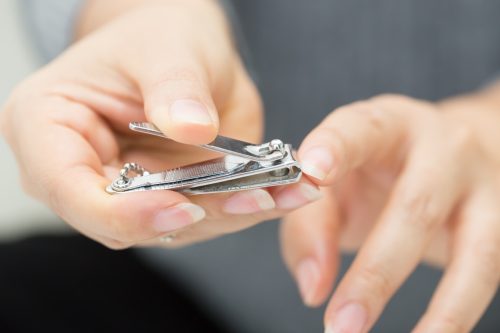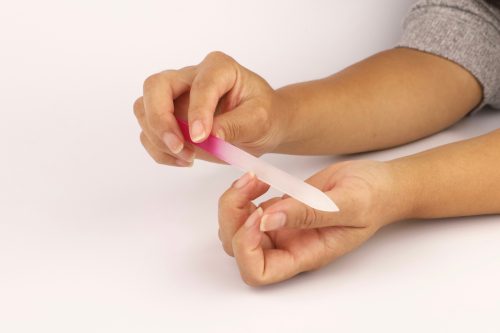Never File Your Nails Without Doing This First, Experts Say
Skipping this step could cause brittle, breakage-prone nails.

Nothing beats a trip to the nail salon. Thanks to the pampering, polish options, and heated towels, you can escape from reality for a little while. But sometimes, an at-home manicure or pedicure is necessary, especially if you're on a tight schedule or need to keep your bank account happy. However, if you're opting for a DIY treatment, there are several guidelines to keep in mind to achieve a healthy, flawless result—including one specific step you should never skip during the process. Read on to discover the one thing manicurists say you should always do before filing your nails.
RELATED: If You're Over 50, Stop Wearing This Nail Polish Color.
Never file your nails before trimming them first.

Whether you're filing your nails as part of an at-home manicure or just to eliminate a rough edge, you should always attempt to clip them first to keep them strong. This is especially true if you're aiming to shorten your nails, says Rianna Farbey, manicurist and director at the Omni Academy of Hair & Beauty. "Excessive filing can cause stress and trauma to the nail, and in some cases, breakage and splitting," she says. That tends to happen whether your nails are too long to start and you're filing them to trim them, or if you have a particularly aggressive rough edge that you're trying to eliminate.
In fact, you may want to incorporate clipping your nails into your routine more often than you already do. According to Healthline, you should trim your nails every week or two, and more frequently if you notice a damaged or split edge. Doing so can help ward off the skin and fungal infections that are sometimes associated with overgrown nails. It can also prevent nails from becoming brittle and weak.
Trim your nails after a bath or shower.

When it comes to cutting your nails before an at-home manicure, timing is everything. "The best time to cut nails is after a bath or shower as the heat and moisture will help to soften the nail structure and help with ease of cutting," says Farbey. She notes this is especially important when trimming toenails, "which can become thicker with age and as a result of nail trauma."
When you move on to filing, it's also important to inspect your form. "You should always file in one direction," says Farbey. "Seesaw filing in a backward and forward motion will cause the layers of the nail to split apart." At the same time, be mindful of your pace. "Go slowly and be careful not to file off too much nail too quickly or you could lose the intended shape or create an imbalance," says Jemma Williams, certified nail technician and editor of Almond Nails. That way, you achieve the desired result with as little filing—and potential damage—as possible.
RELATED: For more beauty advice delivered straight to your inbox, sign up for our daily newsletter.
Invest in a quality nail file.

As with any at-home beauty treatment, you'll want to purchase the proper tools of the trade. Fortunately, choosing a nail file is fairly straightforward. The number one thing you'll want to consider is your file's grit or level of coarseness. The higher the grit, the smoother and gentler the file. According to Sally Beauty, coarse files with 80 to 100 grit are best for acrylic nails, medium files with around 180 grit are best for tips, wraps, and toenails, and fine files with 240 to 600 grit are best for natural nails. An ultra-fine file with 600 to 2,400 grit is best for buffing and shining the nails.
Your at-home manicure routine should mirror the one you'd get at the salon.

You've probably noticed that every time you go to the salon, they follow the same procedure. Well, that should also be the case with your at-home manicure. According to Williams, you can accomplish your mani in a few simple steps.
First, clean your hands and nails. "Removing any dirt and bacteria is essential, not just for the longevity of the manicure, but for hygiene and to keep your nails safe," she says. Then clip, file, and buff your nails; this ensures your polish will adhere to the nail properly. Third, moisturize your nails with cuticle oil. "Cuticle oil will help ensure your nails remain strong and well protected," says Williams. Finally, apply your base coat, color coat, and topcoat. She notes you may need a second color coat before the topcoat, depending on the polish's consistency and hue.
Now that you know the tips, tricks, and necessary tools for an at-home manicure, you'll be well on your way to creating one that rivals the salon.
RELATED: If You See This on Your Nails, It Could Be a Tell-Tale Sign of Diabetes.





















